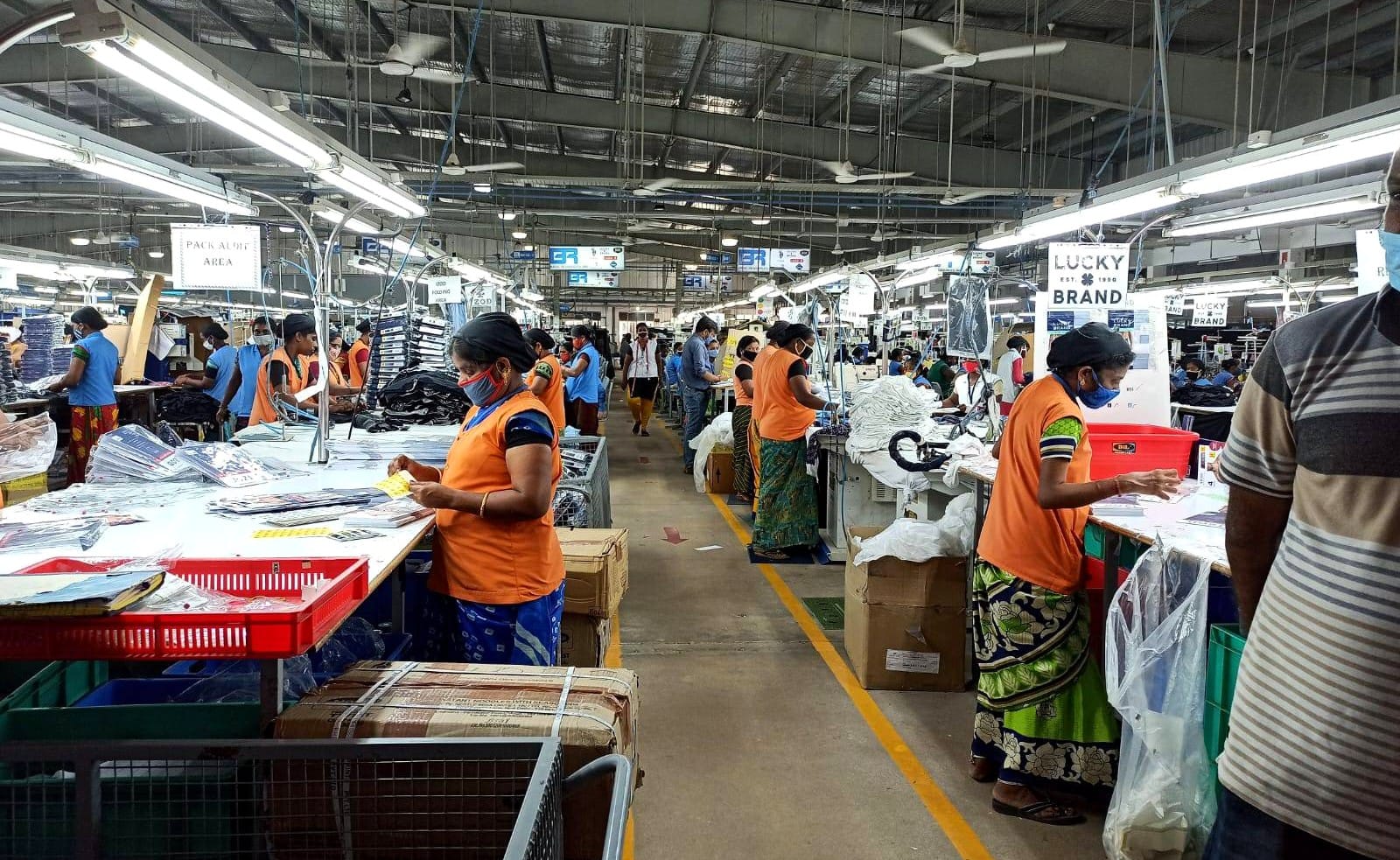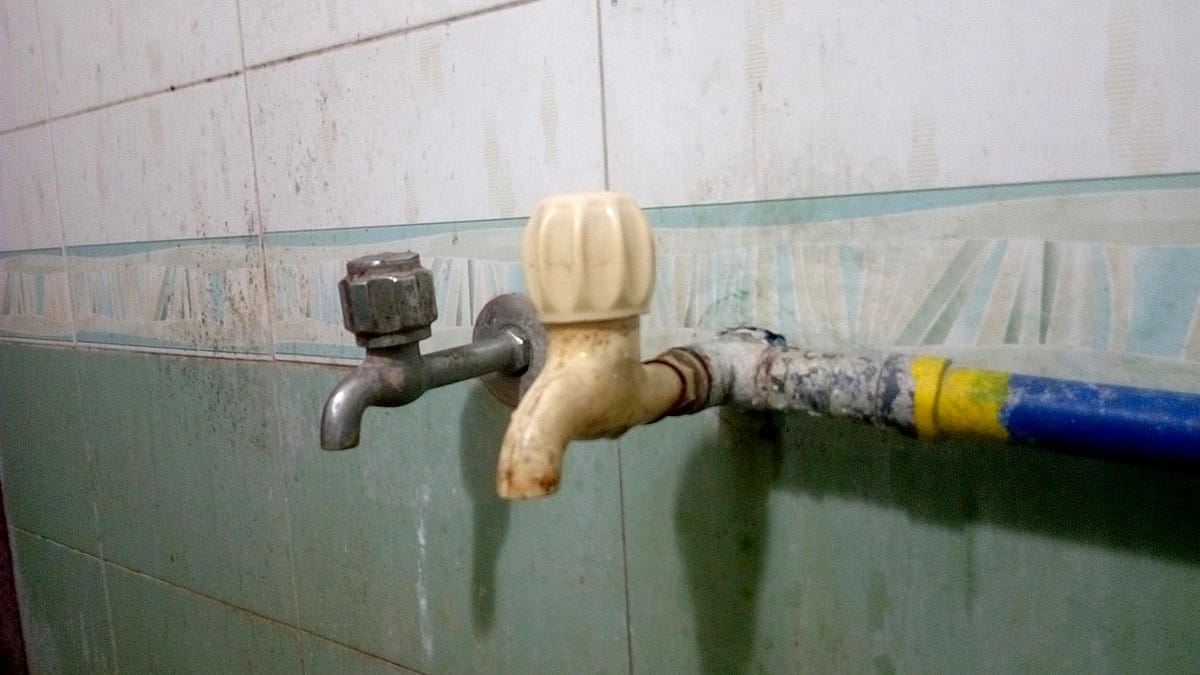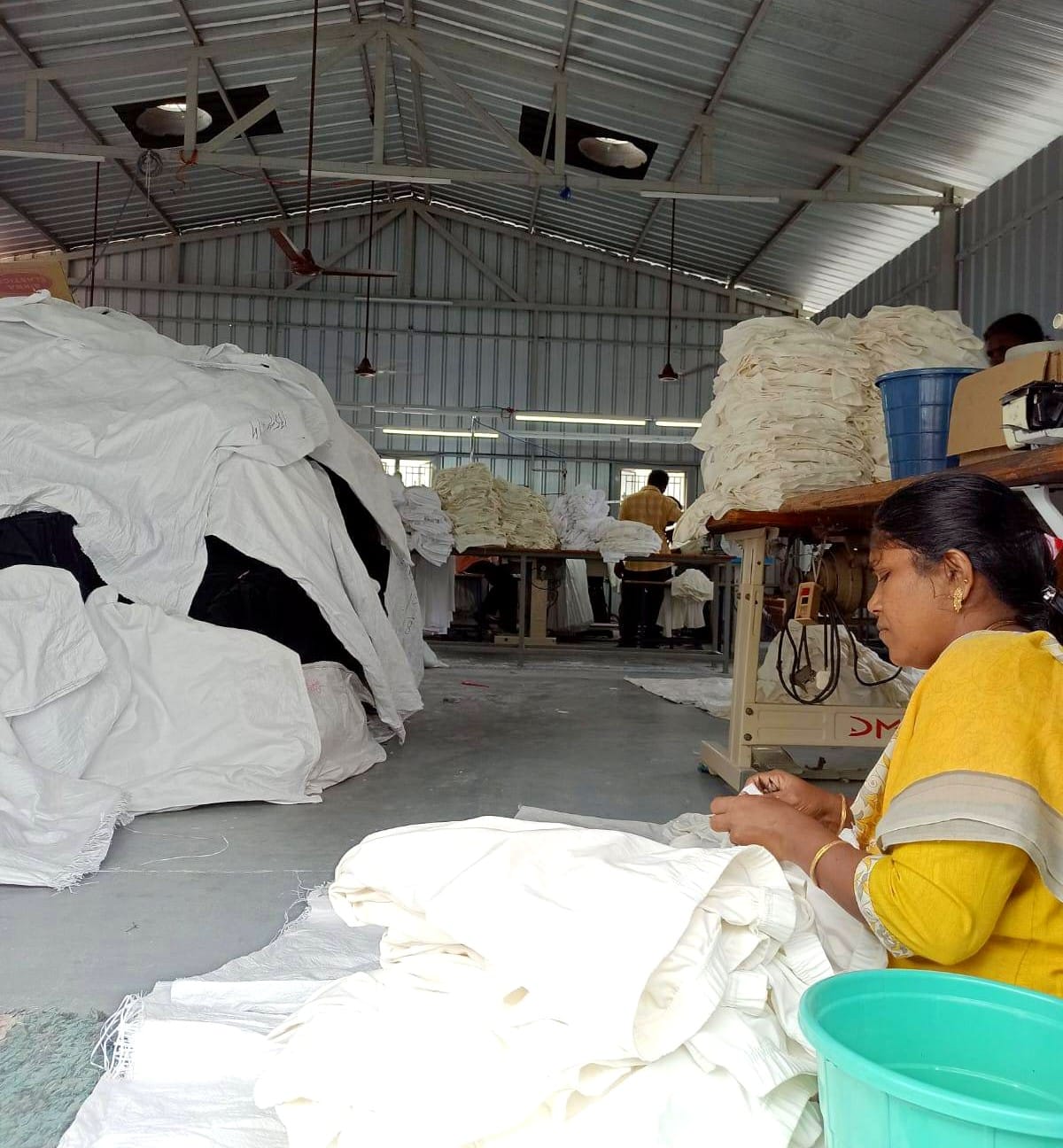Pressure cooker: Heat stress in Tamil Nadu’s garment factories
Guest post from India on the collision of climate change, labour rights and gendered exploitation in Tamil Nadu's garment factories.

Guest Post: Thank you to Nandita Shivakumar and Ranjana Sundaresan for this critically important reporting on the collision of climate change, labour rights and gendered exploitation in Tamil Nadu's garment factories.
Inside sweltering factories: 'We are not allowed to use the bathroom more than twice'
The Erode district is a major textile production hub in Tamil Nadu, India. By April, temperatures had reached 43ºC, 5.2 degrees above normal. In this heat, workers are expected to produce 1,000 units of garments per day. They report a lack of access to clean drinking water and some women even say they are medicating themselves to stop their periods because of the unsanitary and unbearable conditions.
The textile industry in India has an estimated 45 million employees, around 70% of whom are women, making it the largest employer of women in the country after agriculture.
“This year we are seeing an increased number of cases of workers with heat-related stress and dehydration,” said Thivyarakini, state president of the Tamil Nadu Textile and Common Labour Union (TTCU). “In the first week of May, 13 women garment workers reported to me that they were having rashes and increased white discharge. Under-reporting of heat illness in the workplace is very common, resulting in the underestimation of the impact of heat exposure.”
Heat stress – a condition where the body is subjected to higher levels of heat than it can tolerate without physiological impairment – has a multitude of consequences. Fatigue is often the first sign but extreme heat also drains fluids from the body and can lead to heat stroke which can be fatal.
The conditions at many factories are horrific, say workers. To avoid using the bathroom, and also because the water is of poor quality, women workers often avoid drinking water and risk dehydration. Bathroom breaks are also severely curtailed and monitored by factory management. Ambika*, an ironer in a garment factory in Erode, said she fears she will faint from the extreme heat on the factory floor. “I know the risk of this is very high as I don’t drink much water during the day. We are not allowed to use the bathroom more than twice,” she said.
Many workers also skip meals. “The lunch we bring gets spoiled in this heat. The management knows this but we still have to work long hours and deliver,” said Lakshmi*, a spinning mill worker in Dindigul. The lack of water and food saps the energy levels of the women whose work is already physically demanding.
“Many factories do not have working fans or coolers to combat the heat and there is no proper ventilation,” continued Thivyarakini. “The temperature inside garment factories is a few degrees higher because many use tin sheets for roofing. During summer, bathrooms often do not have water in the flush or tap, creating an unhygienic environment.”
She also pointed to the discomfort of working in summer months in the outfits mandated by factories: “Women workers feel suffocated in the multiple layers of clothing, including compulsory uniforms in certain factories and overcoats on top of salwars and sarees, masks, and caps.”

Particularly Hellish For Women
There are women workers, such as Hema*, a tailor in a garment factory in Dindigul, who delay their periods with medication to avoid having to use toilets without a steady water supply. “The factory during the summer months feels like a pressure cooker,” said Hema. “ I know I can’t handle this extreme heat and my period pain together. If I take leave for my periods, I feel I will lose my job.”
Workers say basic first aid for heat sickness is often unavailable: “The nurses in the factory are hardly equipped to handle workers fainting from heat stress and dehydration. There are not even sufficient ORS packets (Oral Rehydration Salts) available in the nurse’s room, and now the management is asking us to bring our own ORS packets,” said Ganga*, a textile worker from Dindigul.
For women, the heat is particularly hellish because it brings on rashes, urinary and vaginal infections that, in many cases, go untreated because workers’ have neither the time nor the wages to address them.
“I have been having severe vaginal irritation and also increased white discharge since the summer started. I also have had red rashes all over my body since April,” said Chellamal*, a checker in a garment factory in Erode. “The nurse in the factory told me that wearing cotton clothes would reduce the rashes and itching, but how can I afford cotton clothes with my wages? I can hardly pay for food and rent with the Rs 8,500 I earn.”

Overheated
Maintaining a core body temperature of around 37°C is essential for continued normal body function, according to data from the Intergovernmental Panel on Climate Change (IPCC) highlighted by the International Labour Organization (ILO). Above this, physical and cognitive functions are impaired; and if the temperature breaches heatstroke levels at 40.6°C, it sharply raises the risk of organ damage, loss of consciousness, and death.
The extreme weather being experienced with increased frequency is a direct result of climate change and its impact will affect lower-income countries the most – those in southern Asia and western Africa are predicted to be the worst-affected. Heat stress has been found to be more prevalent in countries with deficits in decent work standards, like lack of social security and high rates of informal work. Tamil Nadu’s textile industry falls squarely in this hot spot.
Heat-related fatigue also impacts workplace safety and increases the likelihood of injuries. A 2021 paper titled Temperature, Workplace Safety, and Labor Market Inequality looked at nearly 20 years of data on workplace injuries in the US, and found that a higher temperature significantly increased the likelihood of injury at work.
The impact of heat does not necessarily manifest immediately and on the factory floor and this means that it remains unreported, said Rajalakshmi Ramprakash, a public health expert. “Heat exhaustion is slow and insidious – its impact can be both in the short-term and in the long-term. Unlike common occupational accidents and injuries, the physical results of heat exhaustion like dizziness, nausea, and fainting, might happen after a worker reaches home,” she said.
Research on occupational heat stress in India is limited because of challenges like the lack of data, non-cooperation of industries, resistance to change among employers, and so on.
An HR manager at a garment factory said on condition of anonymity that though the maximum permitted temperature in a garment factory is around 30ºC, mid-March onwards this goes up to 36ºC and beyond. “In the afternoons, it goes up to even 40ºC. I know that it is very difficult to work in these conditions, but we have orders which we have to deliver on time – or else we will run into a loss, and won’t be able to pay the workers,” said the official.

‘Can’t Afford Compassion’
The indifference of supplier companies and fashion brands to the plight of the workers means that workers are often labouring over long hours to meet tight delivery schedules in uncomfortable safety gear with poor access to water, sanitation and health facilities.
One production manager said that the excessive heat impacts productivity in summer months but he cannot afford to be compassionate – by offering more breaks or allowing fewer work hours – because of delivery deadlines. “If brands are going to penalise us for delays, how can I create a better workplace for my workers?” the manager said.
Global textile supply chains are largely unregulated by national and international laws. Fashion brands take advantage of this by exploiting a poor and flexible workforce, made up of mostly women, while evading legal liability for labour and human rights violations. They set high targets and tight deadlines then penalise delays even in the most dire of circumstances, and refuse to pay textile suppliers. In turn, suppliers force women workers to work for unsustainably low wages in poor conditions, thus putting their health and lives at risk. This crisis is likely to worsen as heat conditions intensify.
One production manager we spoke to said it is time suppliers and buyers factored the impact of climate change into their costs: “As climate change worsens, I expect there will be longer and harsher summers in Tamil Nadu. We will have to re-think our factory’s overall design to support workers and maintain productivity levels during these months,” the manager said. “Already, water is scarce and we have to purchase expensive drinking water. All this will increase the cost of production and garment suppliers who have low profit margins cannot bear the entire cost of it, without the contribution of fashion brands.”
The names of all factory employees have been changed to protect their identity.
- Nandita Shivakumar is a Business and Human Rights Consultant and advisor to the Tamil Nadu Textile and Common Labour Union (TTCU). She has written extensively on the garment industry and works with multiple garment workers’ unions in developing their campaigns and communication strategies.
- Ranjana Sundaresan is an independent researcher focusing on trends in food and nutrition, and its impacts on women’s health.
- This article was originally published by the brilliant BehanBox newsroom in India: 'Our mission is to mainstream gender journalism with our indepth, evidence-based critical research and reportage.' This version has been edited by me for length.
Notes From The Profit Margins
These are a few things I am keeping my eye on in the industry right now.
- It has been one year since the brutal murder of trade union activist Shahidul Islam in Bangladesh. Brands are still placing orders at the factory where he had been organising and that he was killed outside. Here is a tracker listing the brands who are implicated as buyers and who have not paid compensation to Shahidul Islam's family.
- The ongoing work from the Business & Human Rights Resource Centre into the impact of brand's purchasing practices on the working conditions and rights of garment workers.
- This report on the textile industry's links to toxic "forever chemicals" that are polluting Bangladesh's surface and drinking water.
- This call to stop the rise in child labour in Myanmar where, because of the military coup, 40 per cent of the population is living below the national poverty line and over three million people are internally displaced, one third of them children.
- A call to action - email Primark and tell them to recognise the women-led Garment Labour Union in a factory in India.
- 'How Did Republican Women End Up Like This? The baffling, contradictory demands of being female in the party of Donald Trump.' Get a cup of tea and read this extraordinary article on the 'fevered performances of hyperfemininity and hypermasculinity' being enacted by Republican women.
- And finally... I really liked this essay on Janet Jackson's braids in the iconic film Poetic Justice: 'To say “Respect me no matter how I look” in a world that is fixated on making you run around to fit an aesthetic mold is a muscle that gets stronger with practice.'
Thank you for reading, and thank you again to Nandita and Ranjana.
This newsletter is free - please forward it to a friend or two.
Fingers crossed for the UK General Election this week. Absolutely nothing is certain for progressive candidates - long standing MPs like Jeremy Corbyn and new hopefuls like Faiza Shaheen still need all the help they can get, so please get involved for the last few days and polling day.
In solidarity for the month ahead,
Tansy.